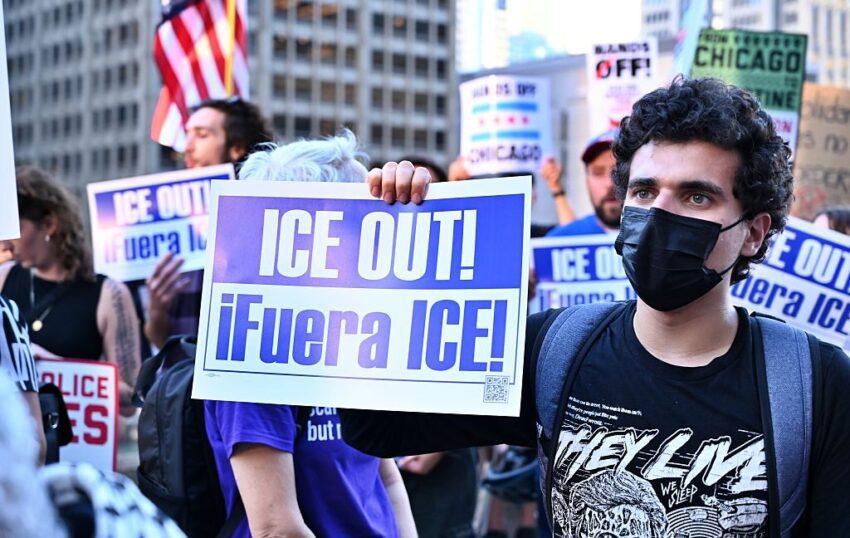
ice s forced face scans to verify Recent reports indicate that Immigration and Customs Enforcement (ICE) and Customs and Border Protection (CBP) are utilizing facial recognition technology on the streets of the United States to verify citizenship status, raising significant constitutional concerns.
ice s forced face scans to verify
Facial Recognition Technology in Action
Social media platforms have become a window into the controversial practices employed by ICE and CBP officers. A video surfaced on a Chicago-based Instagram account, capturing a tense interaction between officers and a self-identified teenager who claimed to be a U.S. citizen. In the video, the teen informs the officers that he does not possess a government-issued ID. Instead, he offers to show his student ID. The officer, seemingly unconvinced, inquires whether facial recognition technology can be utilized, prompting another officer to pull up an application designed for scanning faces.
The first officer instructs the teenager to “relax,” while expressing skepticism about the claims made by many young people regarding their citizenship, suggesting that “a lot of parents” tell their kids they were born in the U.S. The video concludes with the officer taking the minor’s photograph and asking him to confirm that his name aligns with the information retrieved from the app’s database. This incident has sparked outrage and raised questions about the legality and ethics of such practices.
Legal and Ethical Implications
The use of facial recognition technology by law enforcement agencies has been a contentious issue for several years. Critics argue that these practices often lead to racial profiling and violate individuals’ constitutional rights. The Fourth Amendment of the U.S. Constitution protects citizens against unreasonable searches and seizures, and many lawmakers are now questioning whether the forced use of facial recognition technology constitutes a violation of this amendment.
Constitutional Concerns
Lawmakers have voiced their concerns regarding the constitutionality of ICE’s actions. The forced scanning of individuals’ faces without their consent raises significant legal questions. Critics argue that such practices infringe upon personal privacy rights and could lead to wrongful detentions based on inaccurate data. The implications of using facial recognition technology in public spaces are profound, as they may create a chilling effect on individuals’ willingness to engage with law enforcement.
Racial Profiling and Discrimination
One of the most troubling aspects of ICE and CBP’s use of facial recognition technology is the potential for racial profiling. Critics have pointed out that these practices disproportionately target minority communities, exacerbating existing inequalities in the justice system. The reliance on technology that has been shown to have biases—particularly against people of color—raises ethical questions about the fairness and accuracy of such methods.
Background on Facial Recognition Technology
Facial recognition technology has rapidly evolved over the past decade, becoming more accessible and widely used by law enforcement agencies across the United States. Originally developed for security purposes, such as identifying criminals or missing persons, the technology has found its way into everyday policing practices. However, its deployment has not been without controversy.
Historical Context
The use of facial recognition technology gained momentum during the Trump administration, which emphasized a hardline approach to immigration enforcement. This period saw a significant increase in the use of surveillance technologies by law enforcement agencies, including ICE and CBP. Critics argue that this trend has led to a culture of fear among immigrant communities, as individuals may feel they are constantly being monitored.
Technological Limitations
Despite advancements in facial recognition technology, it is not infallible. Studies have shown that the accuracy of these systems can vary significantly based on factors such as lighting, angle, and the demographic characteristics of the individuals being scanned. This raises concerns about the reliability of the technology when used in high-stakes situations, such as verifying citizenship status.
Stakeholder Reactions
The revelations regarding ICE and CBP’s use of facial recognition technology have elicited strong reactions from various stakeholders, including lawmakers, civil rights organizations, and the general public.
Lawmakers’ Responses
Several lawmakers have expressed their outrage over the use of facial recognition technology by ICE and CBP. They argue that the practice is not only unconstitutional but also counterproductive to the goals of law enforcement. Some have called for stricter regulations on the use of facial recognition technology, advocating for transparency and accountability in its deployment.
Civil Rights Organizations
Civil rights organizations have also condemned the use of facial recognition technology in policing. They argue that it perpetuates systemic racism and violates the civil liberties of individuals, particularly those from marginalized communities. Many organizations are advocating for a complete ban on the use of facial recognition technology by law enforcement agencies, citing the potential for abuse and discrimination.
Public Sentiment
The general public’s response to the use of facial recognition technology by ICE and CBP has been mixed. While some individuals support the use of technology to enhance public safety, many others are alarmed by the implications for personal privacy and civil liberties. The viral nature of the social media video has amplified public awareness of these issues, leading to increased scrutiny of law enforcement practices.
Future Considerations
As the debate surrounding facial recognition technology continues, several key considerations emerge for lawmakers, law enforcement agencies, and the public.
Regulatory Framework
There is a growing consensus that a regulatory framework is necessary to govern the use of facial recognition technology by law enforcement. Such regulations could include guidelines for transparency, accuracy, and accountability, ensuring that the technology is used responsibly and ethically. Lawmakers may need to consider legislation that explicitly addresses the use of facial recognition technology in policing, particularly in relation to immigration enforcement.
Public Awareness and Advocacy
Increased public awareness of the implications of facial recognition technology is crucial. Advocacy efforts by civil rights organizations and concerned citizens can play a significant role in shaping the conversation around these issues. Public forums, educational campaigns, and grassroots organizing can help to mobilize support for reforms and raise awareness about the potential dangers of unchecked surveillance.
Technological Accountability
As technology continues to evolve, it is essential to hold developers and law enforcement agencies accountable for the tools they deploy. This includes ensuring that facial recognition systems are rigorously tested for accuracy and bias before being implemented in real-world scenarios. Ongoing oversight and evaluation of these technologies can help to mitigate the risks associated with their use.
Conclusion
The recent revelations regarding ICE and CBP’s use of facial recognition technology to verify citizenship status have sparked a critical conversation about privacy, civil liberties, and the role of technology in law enforcement. As lawmakers, civil rights organizations, and the public grapple with these issues, it is essential to prioritize the protection of individual rights while ensuring public safety. The implications of these practices are far-reaching, and the need for a balanced approach has never been more urgent.
Source: Original report
Was this helpful?
Last Modified: October 30, 2025 at 1:37 am
2 views















